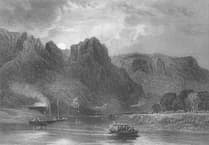FORESTRY England says it has no option but to press on with controversial radical changes to Cannop Ponds.
This week it released a document which sets out the background and range of options for the 200-year-old ponds.
The document, entitled Cannop Ponds: The Next Chapter, explicitly states that doing nothing is not an option.
Forestry England recently received the independent inspection report for Upper Cannop Ponds
This report classifies Upper Cannop as a ‘category B’ reservoir, which is defined as one where a breach or failure could result in a loss of life and cause extensive damage downstream.
Both Upper and Lower Cannop reservoirs are defined as ‘high risk’ by the Environment Agency.
Between them, the ponds store 100,000 cubic metres of water but Forestry England says the dams could not withstand a one-in-150-year flood which could lead to loss of life, cause significant damage in Parkend and Whitecroft and flooding in Lydney.
Deputy Surveyor for the Forest Kevin Stannard said: “Last summer the pubic expressed just how passionately they care for Cannop Ponds. This came as no surprise, and I encourage people to engage with the facts and share their ideas and concerns for the future.
“Our aim has always been to be as open and transparent as we can, which is why we broke the news when we did, while still gathering all the information we need.
“This new document sets out where we are now, the problems we face and what our priorities are for ensuring that the best solution is found. We are committed to ensuring it’s a solution that helps the Forest, its people and wildlife, thrive into the future and remain as resilient as possible against our changing climate and the biodiversity crisis.”
Three broad options have been laid out for the ponds, but Forestry England say it is too early to make sound assessments of their impact.
The proposals are: to repair and replace the dams which are at the centre of flooding concerns, ‘renaturalise’ the area and an “intermediate” option.
The options are contained in Forestry England’s report Cannop Ponds: The Next Chapter which was released this week.
Repairing the dams would involve much larger structures with a wider or deeper spillway.
The document states: “What this all means is that just attempting to retain the Ponds isn’t without significant disruption, draining of the reservoir and change to the existing idyll.
The options to “renaturalise” are variations on removing the dams to return the Cannop Brook to something like the wetland habitat it was before the ponds were built for the iron industry in the early 19th century.
The document states: “By focusing on the natural potential of the land, the renaturalisation of Cannop Ponds has the potential to become a global example of how reinstating a natural aesthetic and ecological functionality can be infinitely more beneficial to the Forest, the community, and the planet.
“A new tapestry of ecosystems, providing homes for many endangered species, a vital stop for migrating birds, and an opportunity to get lost in nature in a way that wasn’t previously accessible.”
The intermediate options could provide storage for stormwater in smaller ponds and lakes, some of which might be suitable for fishing – the current ponds have been home to Yorkley Angling Club for some 60 years.
The document states: “As a result of exploring the alternative options, it’s clear that this doesn’t just have to feel like a legal obligation.
“It’s an opportunity to do so much good – to do what so many other nations have already started, in undoing some unnatural interventions of the past.”
At this stage we do not have enough information to make a sound assessment of any of these options.
“We have commissioned a number of surveys
and further studies to provide us with the necessary information.
“We do know that whatever the future for the Cannop Valley, it will be designed as one for people to enjoy.”
Forestry England says it is committing to sharing information with the public over the coming weeks.
That will lead to a public engagement session where people will be able to have their say.
Wildlife surveys are being undertaken to more fully record what plants, fish, animals and insects use Cannop Ponds currently.
Preliminary ecological and heritage impact assessments have also been commissioned.
Forestry chiefs also say that no decisions have yet been taken about the future of Cannop.
The document can be found at www.forestryengland.uk/sites/default/files/documents/Cannop%20Ponds%20-%20The%20Next%20Chapter.pdf





Comments
This article has no comments yet. Be the first to leave a comment.